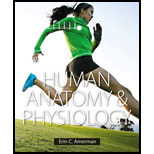
Concept explainers
Which of the following statements is false?
a.
b. Anabolic pathways are exergonic and release energy.
c. Catabolic pathways break larger substances into smaller substances.
d. The body “pays for” anabolic reactions with the energy from catabolic reactions.
Introduction:
All the living organisms require energy to carry out normal functions of the body. The energy obtained from different food sources are used by the body to create useful or essential products which help in growth and reproduction. Metabolism is the sum total of all reactions which takes place in the body and it includes both anabolism and catabolism.
Answer to Problem 1CYR
Correct answer:
Anabolic pathways are exergonic and release energy
Explanation of Solution
Justification/ Explanation for the correct answer:
Option ( b ) states that anabolic pathways release energy as they are exergonic. The statement is false because anabolism is building up a process where small molecules are combined to form a large or complex molecule. Anabolic pathways are endergonic as this reaction needs the energy to create bonds between small molecules. So, option ( b ) is correct.
Explanation for the incorrect answers:
Option (a) states that metabolism includes or refers to all the reactions which take place in the body. The statement is true as metabolism includes both anabolism, or building up process and catabolism, or breaking down process. So, it is an incorrect option.
Option (c) states that catabolic pathways include reactions which break down large complex substances into simpler ones. The statement is true because catabolism is a breaking down process which releases energy. So, it is an incorrect option.
Option (d) states that anabolic reactions get energy from catabolic reactions. The statement is true as the anabolic reactions require energy to create bonds and it is obtained from catabolic reactions which release energy by breaking chemical bonds. So, it is an incorrect option.
Hence, options (a), (c), and (d) are incorrect.
Thus, anabolic pathways are endergonic as it requires energy whereas catabolic pathways are exergonic as it releases energy.
Want to see more full solutions like this?
Chapter 23 Solutions
Human Anatomy & Physiology
- Explain in a small summary how: What genetic information can be obtained from a Punnet square? What genetic information cannot be determined from a Punnet square? Why might a Punnet Square be beneficial to understanding genetics/inheritance?arrow_forwardIn a small summary write down:arrow_forwardNot part of a graded assignment, from a past midtermarrow_forward
- Noggin mutation: The mouse, one of the phenotypic consequences of Noggin mutationis mispatterning of the spinal cord, in the posterior region of the mouse embryo, suchthat in the hindlimb region the more ventral fates are lost, and the dorsal Pax3 domain isexpanded. (this experiment is not in the lectures).a. Hypothesis for why: What would be your hypothesis for why the ventral fatesare lost and dorsal fates expanded? Include in your answer the words notochord,BMP, SHH and either (or both of) surface ectoderm or lateral plate mesodermarrow_forwardNot part of a graded assignment, from a past midtermarrow_forwardNot part of a graded assignment, from a past midtermarrow_forward
 Concepts of BiologyBiologyISBN:9781938168116Author:Samantha Fowler, Rebecca Roush, James WisePublisher:OpenStax College
Concepts of BiologyBiologyISBN:9781938168116Author:Samantha Fowler, Rebecca Roush, James WisePublisher:OpenStax College Comprehensive Medical Assisting: Administrative a...NursingISBN:9781305964792Author:Wilburta Q. Lindh, Carol D. Tamparo, Barbara M. Dahl, Julie Morris, Cindy CorreaPublisher:Cengage Learning
Comprehensive Medical Assisting: Administrative a...NursingISBN:9781305964792Author:Wilburta Q. Lindh, Carol D. Tamparo, Barbara M. Dahl, Julie Morris, Cindy CorreaPublisher:Cengage Learning Human Physiology: From Cells to Systems (MindTap ...BiologyISBN:9781285866932Author:Lauralee SherwoodPublisher:Cengage Learning
Human Physiology: From Cells to Systems (MindTap ...BiologyISBN:9781285866932Author:Lauralee SherwoodPublisher:Cengage Learning Human Biology (MindTap Course List)BiologyISBN:9781305112100Author:Cecie Starr, Beverly McMillanPublisher:Cengage Learning
Human Biology (MindTap Course List)BiologyISBN:9781305112100Author:Cecie Starr, Beverly McMillanPublisher:Cengage Learning





